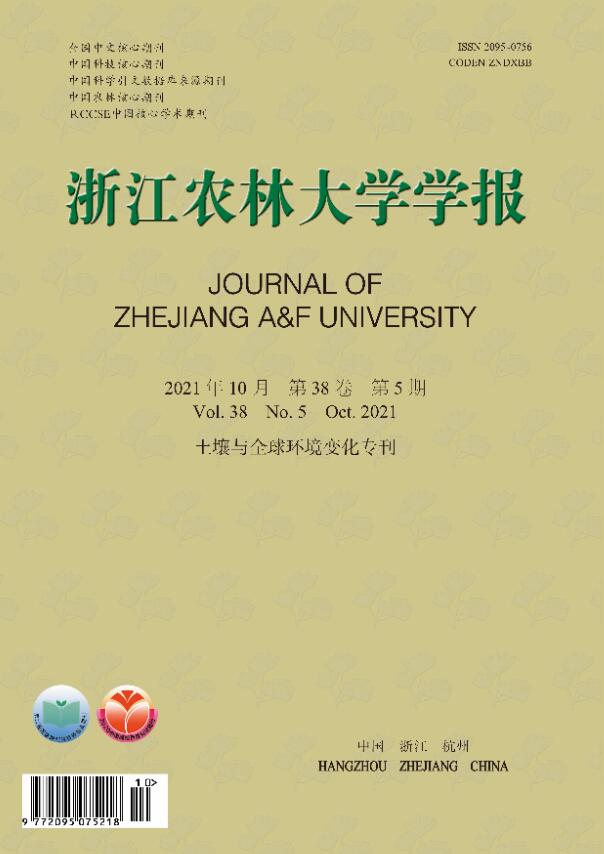-
碳、氮、磷在植物的生长发育过程中发挥着重要的作用,生态化学计量学从元素计量的角度出发,利用生态过程中各种化学元素之间的平衡关系,为研究有机体碳、氮、磷等营养元素在生态系统过程中的变化规律和耦合关系提供了新的研究思路和方法,能更好地阐明生态系统各组分(植物和土壤等)养分比例的协调机制[1-2]。土壤作为生态系统植物生长和发育的基础,为植物的生长和发育提供了所需的养分元素,土壤养分元素的含量和分配对植物的生长和发育起着调控作用,并且影响着植物群落的结构和功能[3]。迄今为止,一些学者对不同林龄植物土壤化学计量的变化特征进行了研究,探讨了植物在不同发育阶段的养分限制因素和养分利用策略[4]。崔宁洁等[5]研究表明:随着马尾松Pinus massoniana林分林龄的增加,土壤碳、氮、磷含量逐渐增加,林分的生长受到氮、磷的共同制约。曹娟等[6]研究表明:随着杉木Cunninghamia lanceolata林龄的增加,土壤有机碳、全氮和全磷含量逐渐增加,土壤有机碳影响着土壤的碳氮比和碳磷比。但是,不同学者的研究结果不尽相同,雷丽群等[7]研究表明:土壤有机碳、全氮含量均随着马尾松林龄的递增呈先降低后增加的趋势,土壤全磷含量在不同林龄之间无显著变化,林龄对土壤碳氮比、氮磷比有极显著的影响。曾凡鹏等[8]研究表明:土壤碳、氮和磷含量随着落叶松Larix gmelinii林分林龄的增加逐渐降低,随着林龄的变化,碳氮比、碳磷比变化显著。由此可见,土壤碳、氮、磷生态化学计量特征随着林龄变化趋势,碳、氮和磷等养分元素间的制约关系仍存在着很大的不确定性,针对不同森林类型需要进一步的研究和探讨。榧树Torreya grandis系红豆杉科Taxaceae常绿乔木,是中国特有的珍稀树种。目前,对榧树的研究主要集中于榧树种质资源调查及分布状况[9]、榧树种群结构和动态[10]等方面,更多则是关于榧树嫁接品种香榧T. grandis ‘Merrilli’的栽培和管理[11-12]研究等。由于榧树的经济价值较小,榧树基本处于自生自灭的状态,严重威胁着榧树种质资源的保存和利用。目前,对榧树的生态化学计量特征的研究较少[13],对不同林龄榧树林地土壤生态化学计量特征的研究则更加欠缺,因此,榧树种质资源的保护和利用缺少技术支撑。本研究以浙江省诸暨市香榧国家森林公园4个不同林龄(0~100、100~300、300~500和>500 a)的榧树资源为研究对象,通过分析榧树林地土壤碳、氮、磷含量及其化学计量特征的变化规律,探讨不同林龄榧树林地土壤养分元素的分配格局,为榧树古树资源的保护和利用提供基础数据。
HTML
-
研究地位于浙江省诸暨市赵家镇香榧国家森林公园(29°21′~29°59′N,119°53′~120°32′E),该区属亚热带季风气候,年均气温为16.3 ℃,年均降水量为1 373.6 mm,年均日照时数为1 887.6 h。研究区属低山丘陵地貌,土壤母质为花岗岩,土壤质地为砂壤土,土壤类型为微酸性红壤。现存天然次生林乔木树种以木荷Schima superba、青冈Cyclobalanopsis glauca为主;林下灌木以豆腐柴Premna micrphylla、朱砂根Ardisia crenanta、四川山矾Symplocos setchuensis等为主;草本有蕨Pteridium aquilinum、芒萁Dicranopteris pedata、阔叶麦冬Liriolpe palatyphylla等。诸暨香榧国家森林公园是中国规模最大的香榧古树集聚地,据统计,树龄100 a以上的榧树约4 200株, 500 a以上的古树约1 600株, 1 000 a以上的古树约200株,以雌株为主[13]。
-
2018年9月中旬,通过资料查阅、农户访问、生长锥调查和年轮分析(结合榧树生长状况、形态特征、外观老化程度、树种的生物学特性及相关的调查结果综合分析确定树木的年龄),选择立地条件基本一致的不同年龄段的实生榧树,按0~100、100~300、300~500以及>500 a的树龄梯度选择样本树(参考古树名木的管理方法划分林龄梯度),每个林龄段的样本树各重复4~5株。测定所选样株胸径、树高和林下植被生长情况(包括植物种类、高度、盖度和株树)等基本特征。同时在距离榧树树体50~100 cm左右的树冠下(东南西北4个方位),随机挖取4个土壤剖面(避开粗根系),分别采集0~20、20~40和40~60 cm土层土样,同一土层样品充分混合,去掉可见植物根系、残体和碎石,分别标号后带回实验室,自然风干备用。所有调查样株分布在半径为500 m的范围内,以保证气候、坡度、坡向和成土母质等环境因子基本一致,并且所有选择的样本经营管理措施大体相同(由于样株呈单株分布,因此,不同林龄段林下植被种类和盖度等大体一致。所有选择的调查样株每年地表除草1次,不施肥、不垦覆),整个试验具有可比性,样地基本情况见表1。
林龄/a 平均胸
径/cm平均树
高/m平均坡
度/(°)平均海
拔/m土壤
pH分布情况 0~100 35.56 10 27 512 4.76 单株 100~300 57.11 17 24 532 4.95 单株 300~500 60.19 17 27 472 4.85 单株 >500 99.15 19 36 514 5.25 单株 Table 1. General information of sample plots
自然风干后的土样分别过2.00、0.25和0.15 mm筛备用。土壤有机碳(SOC)采用重铬酸钾外加热法测定;土壤全氮(STN)采用浓硫酸消煮,凯氏定氮法测定;土壤全磷采用高氯酸-硫酸法(HClO4-H2SO4)消煮,钼锑抗比色法测定[14]。
-
采用Excel 2010对数据进行整理和预处理,利用SPSS 22.0对不同林龄榧树林地土壤碳、氮、磷质量分数及化学计量特征进行单因素方差分析(one-way ANOVA)和显著性分析(LSD检验),采用Pearson分析方法对不同林龄段各土层土壤有机碳、全氮、全磷质量分数及化学计量特征进行相关性分析。
1.1. 研究区概况
1.2. 研究方法
1.2.1. 样株选择和样品采集
1.2.2. 数据处理
-
由表2可知:不同林龄榧树林地土壤碳质量分数为10.90~24.22 g·kg−1,同一土层土壤碳质量分数随林龄变化呈先增加后降低的趋势,且在3个土层中,林龄0~100 a的林地土壤碳质量分数均为最低。不同林龄榧树林地土壤氮质量分数为1.22~2.22 g·kg−1,同一土层土壤氮质量分数随林龄变化也呈先增加后降低的趋势,且在3个土层中,林龄0~100 a的林地土壤氮质量分数也为最低。不同林龄榧树林地土壤磷质量分数为0.24~0.80 g·kg−1,同一土层土壤磷质量分数随林龄变化呈先降低后增加的趋势,在3个土层中,林龄100~300 a 的林地土壤磷质量分数均为最低。但是,同一土层不同林龄榧树林地土壤碳、氮、磷之间均无显著差异。
土层/cm 林龄/a 碳/(g·kg−1) 氮/(g·kg−1) 磷/(g·kg−1) 0~20 0~100 20.21±2.29 a 1.86±0.17 a 0.80±0.48 a 100~300 24.22±5.83 a 2.22±0.47 a 0.40±0.13 a 300~500 22.07±1.70 a 2.12±0.29 a 0.53±0.28 a >500 21.28±6.80 a 2.02±0.53 a 0.69±0.25 a 20~40 0~100 12.27±1.52 a 1.28±0.21 a 0.46±0.19 a 100~300 16.75±6.87a 1.61±0.56 a 0.26±0.07 a 300~500 15.02±1.00 a 1.62±0.34 a 0.36±0.07 a >500 14.23±8.50 a 1.44±0.69 a 0.38±0.13 a 40~60 0~100 10.90±2.96 a 1.22±0.26 a 0.33±0.08 a 100~300 15.20±4.79 a 1.42±0.44 a 0.24±0.06 a 300~500 15.97±3.21 a 1.55±0.10 a 0.34±0.08 a >500 13.16±8.05 a 1.43±0.55 a 0.32±0.14 a 说明:同列不同字母表示同一土层不同林龄间差异显著 (P<0.05) Table 2. Soil C, N, and P contents in four ages of T. grandis
-
由表3可知:不同林龄榧树林地土壤碳氮比均值为8.59~10.89,同一土层不同林龄间土壤碳氮比差异均不显著,且随林龄变化均呈先增加后降低的趋势。不同林龄榧树林地土壤碳磷比为31.54~63.72,同一土层不同林龄间土壤碳磷比随林龄变化也呈先增加后降低的趋势,其中,在土层20~40、40~60 cm中,林龄0~100 a的碳磷比分别显著小于林龄100~300 a(P<0.05)。不同林龄榧树林地土壤氮磷比为3.06~6.16,同一土层不同林龄间土壤氮磷比随林龄变化呈先增加后降低的趋势,同一土层各林龄段之间土壤氮磷比均无显著差异。
土层/cm 林龄/a 碳氮比 碳磷比 氮磷比 0~20 0~100 10.85±0.65 a 35.03±26.80 a 3.32±2.73 a 100~300 10.89±0.60 a 62.78±16.33 a 5.80±1.63 a 300~500 10.47±1.01 a 49.88±25.89 a 4.71±2.37 a >500 10.38±0.89 a 31.54±6.21 a 3.06±0.65 a 20~40 0~100 9.66±0.41 a 32.00±18.08 b 3.35±1.96 a 100~300 10.27±0.71 a 63.72±15.73 a 6.16±1.08 a 300~500 9.75±1.03 a 47.03±14.61 ab 4.82±1.45 a >500 9.34±1.72a 35.03±13.01 ab 3.66±0.82 a 40~60 0~100 8.87±0.75 a 35.27±16.52 b 3.89±1.52 a 100~300 10.71±0.26 a 62.01±6.22 a 5.79±0.47 a 300~500 9.88±1.12 a 45.73±15.65 ab 4.62±1.56 a >500 8.59±3.11 a 40.51±21.31 ab 4.51±1.09 a 说明:同列不同字母表示同一土层不同林龄间差异显著 (P<0.05) Table 3. Ratios of soil C∶N, C∶P, and N∶P in four ages of T. grandis
-
从表4可见:各林龄榧树林地土壤碳、氮、磷质量分数之间有较强的正相关关系,其中碳和氮达到极显著正相关关系(P<0.01);碳和磷在榧树林龄>500 a时呈极显著正相关(P<0.01),在榧树林龄0~100和100~300之间相关显著(P<0.05);氮和磷在榧树林龄100~300 a时呈显著相关(P<0.05),在榧树林龄>500 a时呈极显著相关(P<0.01)。各林龄段土壤磷与碳磷比、氮磷比均为负相关关系,在林龄0~100和300~500 a时达显著水平(P<0.05),相关系数分别为−0.687和−0.768。整体上,各林龄榧树林地土壤化学计量比相关性较弱,碳磷比和氮磷比相关性均达极显著水平(P<0.01),相关系数分别为0.990、0.967、0.970和0.807。
林龄/a 指标 碳 氮 磷 碳氮比 碳磷比 氮磷比 0~100 碳 1 氮 0.979** 1 磷 0.715* 0.625 1 碳氮比 0.859** 0.746* 0.719* 1 碳磷比 −0.002 0.080 −0.687* −0.102 1 氮磷比 −0.120 −0.025 −0.768* −0.235 0.990** 1 100~300 碳 1 氮 0.993** 1 磷 0.765* 0.745* 1 碳氮比 0.640 0.544 0.558 1 碳磷比 0.453 0.457 −0.215 0.279 1 氮磷比 0.299 0.329 −0.372 0.025 0.967** 1.000 300~500 碳 1 氮 0.904** 1 磷 0.290 0.449 1 碳氮比 0.384 −0.043 −0.236 1 碳磷比 0.446 0.283 −0.698* 0.388 1 氮磷比 0.361 0.297 −0.699* 0.156 0.970** 1 >500 碳 1 氮 0.987** 1 磷 0.812** 0.814** 1 碳氮比 0.861** 0.778* 0.582 1 碳磷比 0.424 0.355 −0.123 0.670* 1 氮磷比 0.017 −0.011 −0.510 0.222 0.870** 1 说明:*表示P<0.05,**表示P<0.01 Table 4. Relationship between soil C, N, P contents and stoichimetric in four ages
2.1. 不同林龄榧树林地土壤碳、氮、磷变化特征
2.2. 不同林龄榧树林地土壤碳、氮、磷化学计量变化特征
2.3. 不同林龄榧树林地土壤碳、氮、磷质量分数及化学计量特征间的相关关系
-
本研究中,不同林龄实生榧树林地0~60 cm土层碳质量分数为10.90~24.22 g·kg−1,且不同林龄之间差异不显著,这与张芸等[15]对4个林龄杉木林土壤碳含量的研究结果一致。并且,随着榧树林龄的增加,土壤碳质量分数呈先升高后降低的趋势,且在林龄0~100 a最低。杨好运等[16]对柑橘Citrus reticulata、胡士达[17]对闽楠Phoebe bournei的研究结果表明:土壤碳质量分数从大到小依次为幼林龄、成熟林、近成熟林。与其研究结果不同的原因可能是,地表凋落物的分解是土壤有机碳的主要来源,林分总生物量、碳储量和养分储量随林龄的增加呈增大趋势[18],相对于林龄100~300、300~500和>500 a的榧树,0~100 a榧树处于生长初期,个体生长旺盛,凋落物数量也相对较少,而林龄100~300和300~500 a的榧树,树冠郁闭度高,冠幅和树高逐渐增大,产生的凋落物数量较多,林龄>500 a的榧树生长开始衰退,林冠开始稀疏,凋落物回归到地表的数量减少,导致归还到土壤的养分元素减少。
随着榧树林龄的增加,土壤氮与碳的质量分数变化趋势大体一致,呈先增加后降低的趋势,并且相对稳定,与苗娟等[19]对不同林龄云南松Pinus yunnanensis土壤碳氮质量分数有一致的变化趋势,说明林龄≤500 a的榧树生长较为旺盛,对土壤氮素的需求较高,因此土壤氮未出现积累[20]。
整体上,榧树林龄增加对土壤磷质量分数均未产生显著影响,土壤磷质量分数随林龄增加呈先下降后升高的趋势。但曹娟等[21]研究表明:杉木土壤磷含量随林龄增加呈先升高后降低的趋势。这可能是因为,在林龄0~100 a的榧树树体相对较小,个体生长旺盛,对土壤氮的需求较大,而对磷的需求相对较少,所以土壤氮质量分数最低,而土壤磷质量分数较高;而林龄100~300和300~500 a的榧树,随着树体的增加,凋落物的分解基本上能够满足植物体对氮的需求,所以土壤氮变化相对平稳;在林龄100~300和300~500 a的榧树,由于种子结实量增加,榧树对磷的需求量增加,所以导致土壤磷质量分数下降。
-
土壤碳、氮、磷等养分元素的循环过程是相互耦合和相互影响的,土壤中碳氮比、碳磷比等存在一定的比例关系。土壤碳氮比是衡量土壤碳、氮的平衡状况和土壤氮素矿化能力的重要指标,碳氮比较低时,有利于提升土壤微生物的分解能力,表明土壤有机质矿化速率加强[22-23],超过微生物所需的氮被释放到土壤中,从而有利于土壤氮的增加;而碳氮比较高时,由于存在氮受限,微生物分解能力下降,进而促进了土壤碳的积累[24-25]。本研究榧树林地土壤碳氮比为8.59~10.89,变化幅度较小,且均低于中国土壤平均值(11.9)和世界土壤平均值(13.3)[26],说明研究区榧树林地土壤微生物分解能力强,土壤有机质矿化速率快。YANG等[27]对39个森林林龄序列的土壤碳氮数据的统计分析表明:土壤碳氮比随着林龄序列的变化相对恒定。森林土壤中碳、氮元素主要来自于凋落物的分解,土壤微生物严格按照元素计量比分解凋落物,使得土壤中的碳氮比相对稳定[28]。
土壤有机质的分解速率受到土壤磷有效性的影响,因此,土壤碳磷比可作为微生物分解土壤有机质释放磷的指标,较低的碳磷比是磷有效性高的指标之一[29]。林龄0~100、300~500和>500 a的榧树林地土壤碳磷比均小于中国土壤平均值(61)[30],而林龄100~300 a的榧树林地土壤碳磷比稍高于中国土壤平均值(61),有利于榧树林地微生物对磷的净矿化作用。不同林龄段榧树土壤碳磷比差异并不显著,但相对来说,林龄100~300和300~500 a的榧树林地土壤碳磷比较高,说明随着榧树林龄的增加,榧树土壤中磷质量分数下降。磷是影响研究区榧树林地土壤碳磷比生态计量比的关键因素,因此,榧树整个生长和发育过程对磷需求大,如果土壤磷没有得到及时的补充,则林地处于磷过度消耗的状态。土壤氮磷比可作为指示土壤养分供应情况的指标[31],可以直接反映土壤肥力并间接表明植物营养状况[32],也可以反映土壤中氮的限制与饱和状况[33]。除了林龄100~300 a的榧树林地土壤氮磷比高于全国土壤平均值(5.2)外,其他林龄段氮磷比均低于全国土壤平均值,并且氮磷比与磷呈负相关关系,这与任悦等[34]对沙地樟子松Pinus sylvestris var. mongolica的研究结果一致。不同林龄榧树林地土壤磷为0.24~0.80 g·kg−1,除了林龄0~100 a,土层0~20 cm的磷稍高于全国平均值(0.78 g·kg−1)外[34],其余均低于全国平均值。结合中国亚热带红壤区磷普遍较低的问题,综合分析认为:榧树整个生长阶段林地土壤主要受到磷限制,因此对榧树经营时,可以合理施加磷肥来改善土壤肥力状况。亚热带红壤无机磷主要以铝结合态磷(Al-P)、铁结合态磷(Fe-P)、钙磷(Ca-P)为主,而植物可以吸收利用的有效态磷较少,人工林生长后期,生长往往受到磷元素的限制。HUANG等[33]研究表明:鼎湖山3种不同森林类型根际土壤酸性磷酸酶的活性随着林龄的增加呈增加趋势,根际土壤有效磷的含量也随之下降。表明在亚热带红壤区,随着林木的生长,磷受限将加剧,在人工林发育中后期应适当增施磷肥,以保证林木的良好生长,促进土壤与植物的良性养分循环。研究区亚热带红壤磷整体上处于低水平,导致土壤氮、磷元素失衡,从而影响林木的生长发育和生态系统物质及能量循环。
-
由相关性分析可知:不同林龄段榧树林地土壤碳、氮质量分数均表现出极强的正相关关系,这是因为氮会影响土壤对碳的固定,土壤碳和氮有很强的依存性[33]。各林龄段榧树林地土壤碳和磷也表现出很强的相关性。各林龄段榧树林地土壤碳氮比与碳的相关性均大于碳氮比与氮的相关性,说明各林龄榧树土壤碳氮比主要受碳的影响,氮磷比更多受到磷的影响。
3.1. 不同林龄段实生榧树林地土壤碳、氮、磷质量分数
3.2. 不同林龄实生榧树林地土壤碳、氮、磷生态化学计量特征
3.3. 不同林龄土壤碳、氮、磷质量分数及化学计量特征相关性分析
-
本研究同一土层不同林龄段榧树林地土壤碳、氮、磷质量分数差异不显著,同一土层不同林龄段之间碳氮比、氮磷比差异也不显著,碳磷比在部分林龄段差异显著,榧树整个生长阶段土壤磷质量分数低于全国平均值,表明榧树林地土壤主要受磷的限制,因此对榧树林地经营时,可以合理添加磷肥来改善土壤肥力。









 DownLoad:
DownLoad: